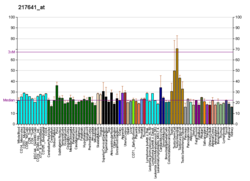Protein-coding gene in the species Homo sapiens
Probable G-protein coupled receptor 135 is a protein that in humans is encoded by the GPR135 gene.[5][6]
- Kunz D, Gerard NP, Gerard C (1992). "The human leukocyte platelet-activating factor receptor. cDNA cloning, cell surface expression, and construction of a novel epitope-bearing analog". J. Biol. Chem. 267 (13): 9101–6. doi:10.1016/S0021-9258(19)50394-5. PMID 1374385.
- Strausberg RL, Feingold EA, Grouse LH, et al. (2003). "Generation and initial analysis of more than 15,000 full-length human and mouse cDNA sequences". Proc. Natl. Acad. Sci. U.S.A. 99 (26): 16899–903. Bibcode:2002PNAS...9916899M. doi:10.1073/pnas.242603899. PMC 139241. PMID 12477932.
- Vassilatis DK, Hohmann JG, Zeng H, et al. (2003). "The G protein-coupled receptor repertoires of human and mouse". Proc. Natl. Acad. Sci. U.S.A. 100 (8): 4903–8. Bibcode:2003PNAS..100.4903V. doi:10.1073/pnas.0230374100. PMC 153653. PMID 12679517.
- Vanti WB, Nguyen T, Cheng R, et al. (2003). "Novel human G-protein-coupled receptors". Biochem. Biophys. Res. Commun. 305 (1): 67–71. doi:10.1016/S0006-291X(03)00709-5. PMID 12732197.
- Gerhard DS, Wagner L, Feingold EA, et al. (2004). "The status, quality, and expansion of the NIH full-length cDNA project: the Mammalian Gene Collection (MGC)". Genome Res. 14 (10B): 2121–7. doi:10.1101/gr.2596504. PMC 528928. PMID 15489334.






